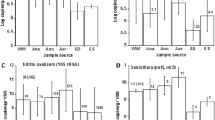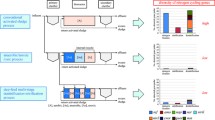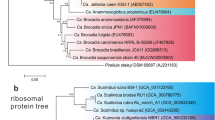Abstract
The genetic diversity and expression of amoA of autotrophic ammonia oxidizers in wastewater treatment processes were investigated by RT-PCR and denaturing gradient gel electrophoresis (DGGE) in order to identify active components of ammonia-oxidizer populations in a such processes. Ammonia oxidizers, evidenced by the presence of amoA mRNA, were regarded as metabolically active. The DGGE profiles derived from amoA mRNA and from its gene, which were amplified by RT-PCR or PCR using samples collected from a bench-scale reactor treating high concentration of inorganic ammonia, were similar. In contrast, RNA and DNA-derived DGGE profiles from three domestic wastewater treatment facilities were different from each other. These data indicate that the dominant ammonia oxidizers in the bench-scale reactor exhibited ammonia-oxidizing activity, whereas some ammonia oxidizers in the domestic wastewater treatment facilities apparently did not express high levels of amoA mRNA.
Similar content being viewed by others
Avoid common mistakes on your manuscript.
Introduction
Molecular techniques such as denaturing gradient gel electrophoresis (DGGE) and fluorescence in situ hybridization (FISH) based on SSU rDNA and rRNA and functional genes have been used to analyze ammonia-oxidizer populations (Kowalchuk et al. 1997; Mobarry et al. 1996; Rotthauwe et al. 1997). However, molecular analyses based on 16S rDNA information and the gene amoA are unable to estimate the actual in situ ammonia-oxidizing activity. In fact, Mendum et al. (1999) reported that ammonia-oxidizer populations did not change significantly, even with a large increase in nitrification rates following the addition of ammonium to soils.
Techniques that focus on specific and transient markers of in situ metabolism, such as mRNA, offer the possibility of measuring specific metabolic activity. The retrieved transcripts can be used to compare the environmental expression of individual members of gene families. Thus, when applied to field samples, mRNA-based analysis may be useful in determining the relationships between environmental conditions in microbial habitats and particular in situ activities of native microorganisms (Wilson et al. 1999).
In this study, we introduce an approach to investigating the community structure of ammonia oxidizers, which are responsible for ammonia oxidation, based on the expression of amoA mRNA. Furthermore, using comparative sequence analyses of RT-PCR products and PCR products targeting, respectively, amoA mRNA and its gene, we provide information on the microbial community responsible for ammonia oxidation in wastewater treatment processes.
Materials and methods
Bacterial strains and environmental samples
Nitrosomonas europaea IFO 14298 was cultured and collected by centrifugation. Biofilm samples were collected from a bench-scale reactor into which ammonia-rich inorganic artificial wastewater (2.357 g (NH4)2SO4 l−1, 6.044 g Na2SO4 l−1, 7 g NaHCO3 l−1, 5 mg FeSO4·7H2O l−1, 4 mg KH2PO4 l−1) was fed. Activated sludge samples were collected from three household-type septic tanks treating domestic wastewater. An activated sludge process and membrane filtration were used in all of the septic tanks. The ammonium loads of the bench-scale reactor and of the septic tanks were 0.80 and 0.15 kg N m−3 day−1, respectively. At the time of sampling, all reactors exhibited active nitrification.
DNA and RNA extraction
DNA was extracted according to the method of Hoshino et al. (2001), except for the cell disruption procedure. Cells were homogenized with Mini-beadbeater-8 (BioSpec Products) set at the homogenize level for 2 min in the presence of 1 g glass beads (diameter, 0.1 mm; BioSpec Products, Bartlesville, Okla., USA).
Total RNA was extracted with an ISOGEN reagent (Nippon Gene, Tokyo, Japan), according to the manufacturer’s protocol, except that the cell disruption procedure mentioned above was used. Remaining DNA was digested with RNase-free DNase I (TaKaRa Shuzou, Siga, Japan) according to a procedure of Ward et al. (1995). The amount and purity of DNA and RNA were estimated spectrophotometrically by measuring the optical density at 260 and 280 nm. DNA was stored at −20 °C and RNA at −80 °C.
Reverse transcription
The 20-µl reaction volume contained 4 µl 5× RT buffer, 20 nmol of each deoxynucleoside triphosphate, 10 U RNase inhibitor, 10 pmol amoA-2R primer (Rotthauwe et al. 1997), approximately 0.4 µg template RNA, and 100 U reverse transcriptase, ReverTra Ace (TOYOBO, Osaka, Japan). The reverse transcription reaction was carried out at 50 °C for 30 min, followed by denaturation, RNase inactivation at 99 °C for 5 min, and final cooling at 4 °C for 5 min using a GeneAmp PCR System 9700 (Applied Biosystems, Foster City, Calif., USA).
RT-PCR and PCR amplifications
The first-strand cDNAs transcribed from total RNA and extracted DNA were amplified with primers amoA-1F and amoA-2R (Rotthauwe et al. 1997). The reaction mixture was prepared in a total volume of 50 µl, containing 5 µl 10× PCR buffer, 100 nmol MgSO4, 10 nmol of each deoxynucleoside triphosphate, 25 pmol of each primer, 1 µl of the first-strand cDNA or approximately 150 ng extracted DNA, and 1 U of DNA polymerase, KOD Plus (TOYOBO). The thermal cycling comprised an initial denaturation at 94 °C for 1 min, followed by 35 cycles of denaturation at 94 °C for 20 s, annealing at 58 °C for 10 s, and elongation at 72 °C for 20 s, and a final extension at 72 °C for 1 min. PCR of extracted RNA without the RT step was carried out as a control for DNA contamination. PCR products were electrophoresed in a 2% agarose gel and visualized by ethidium bromide staining.
For DGGE, PCR products were used as template for a second PCR. The latter PCR was done with primer amoA-1F-GC, which was attached to the 40-nucleotide GC-rich sequence. The amoA-2R primer has two degeneracies and primers with no degeneracy were constructed (Nicolaisen and Ramsing 2002) for the second PCR. The PCR band intensity on the agarose gel was measured and DNA amounts were estimated with software( Kodak 1D ver.2.0).
DGGE
DGGE was done with a D-Code Multi-system (Bio-Rad Laboratories, Hercules, Calif., USA). Approximately 100 ng of each product was loaded onto 8% (wtv) polyacrylamide gels with a denaturing gradient of 27–45%. The gels were run at 60 °C for 4 h at 130 V. After electrophoresis, the gels were soaked in SYBR Gold nucleic acid gel stain (1:10,000 dilution; Molecular Probes, Eugene, Ore., USA) for 30 min and photographed.
Sequencing and phylogenetic analysis
DNA was extracted from the excised gels with a QIAEX II DNA extraction kit (QIAGEN, Hilden, Germany), and reamplified with the amoA-1F and amoA-2R primer set described above. amoA fragments were sequenced with a BigDye Terminator cycle sequencing kit (Applied Biosystems) and an ABI PRISM 377 DNA Sequencing system (Applied Biosystems).
The sequences determined in this study were compared with other available sequences using the BLAST search option of the DDBJ (DNA Data Bank of Japan) and were aligned using Clustal W with DDBJ. Neighbor-joining trees were constructed using Clustal W with DDBJ and Tree View (Thompson et al. 1994).
Nucleotide sequence accession numbers
The nucleotide sequences reported in this study have been deposited in the DDBJ nucleotide sequence database under accession numbers AB121113-AB121135.
Results
Amplification of amoA fragment for DGGE
The semi-nested strategy, consisting of an initial PCR without a GC-clamp followed by a second PCR using GC-clamp primers avoided unspecific priming (Nicolaisen and Ramsing 2002). However, DGGE of the pure culture amplicons revealed quartet bands for N. europaea (Fig. 1a). When each of the amoA-2R degenerate primer set was separately used for PCR-DGGE of N. europaea, the DGGE band pattern was confirmed, although the individual primers generated DGGE bands with different mobilities (Fig. 1a). PCR-DGGE of activated sludge collected from septic tank was also done using the original degenerate primers or non-degenerate primers, the same phenomenon was observed (Fig. 1b). Since there was little difference in the DGGE band patterns, one of the components of primer amoA-2R, amoA-2R-(g-c), was used in this study as a reverse primer for the second PCR, followed by DGGE.
Denaturing gradient gel electrophoresis (DGGE) profiles of amoA fragments amplified from a Nitrosomonas europaea and b septic tank B with amoA-1F-gc and several reverse primers. The reverse primer amoA-2R comprises amoA-2R-(g-g), amoA-2R-(g-c), amoA-2R-(t-g), and amoA-2R-(t-c), and all reverse primers included in amoA-2R were used
DGGE band profiles of RT-PCR and PCR products
Comparison of the community structure of ammonia oxidizers based on amoA mRNA and its gene was done on all the samples using DGGE (Fig. 2). Surprisingly, only the bench-scale reactor sample showed high similarity between amoA and amoA mRNA DGGE band profiles. In the remaining three samples, collected from septic tanks A, B, and C, differences in DGGE band profiles between amoA mRNA and its gene were observed.
Furthermore, the community structure of ammonia oxidizers in the bench-scale reactor was similar to that in septic tank C but significantly different from those in septic tanks A and B, based on analysis of variations in amoA. However, comparison of amoA mRNA expression demonstrated that the DGGE band profile derived from amoA mRNA of sample collected from the bench-scale reactor was different from those of the three septic tank samples, which were similar to each other.
Phylogenetic analysis of DGGE fragments
All amoA sequences determined for the four samples were categorized into three distinct lineages belonging to the Nitrosomonas branch. These sequences showed very high similarity between samples; the levels of nucleotide and amino acid identity ranged from 76.1 to 100% and from 82.7 to 100%, respectively. Moreover, 116 of 149 amino acid residues were conserved in all sequences.
Almost all sequences derived from amoA mRNA and amoA that were retrieved from the bench-scale reactor occupied the same cluster, whereas those collected from the three septic tanks formed different clusters. Furthermore, amoA mRNA and amoA sequences from the bench-scale reactor sample and those from septic tank C sample were affiliated with the Nitrosomonas europaea lineage. In contrast, amoA gene sequences from septic tanks A and B samples and amoA mRNA from septic tanks A, B, and C samples formed two independent clusters different from those of previously isolated species recorded in the database.
Discussion
The primers used in this study were designed specifically to amplify a stretch of amoA from a wide range of autotrophic ammonia oxidizers (Rotthauwe et al. 1997). However, multiple amoA DGGE bands caused by the degenerate amoA-2R primer were obtained. This side effect of using a degenerate primer has been previously reported (Nicolaisen and Ramsing 2002). Hence, the primers seem to amplify the same target sequences, and the multiple DGGE bands were ascribed to differences in the primer sequence. Consequently, amplification with one of the components of the amoA-2R was a reasonable approach for use in DGGE analysis.
The DGGE profiles and subsequent phylogenetic analysis based on amoA mRNA and amoA indicate that almost all the ammonia oxidizers detected based on the gene amoA expressed amoA mRNA, and were responsible for ammonia oxidation in the bench-scale reactor. Conversely, in the septic tank, some ammonia oxidizers were not involved in ammonia oxidation. Since the effluent water of the septic tank was drawn through a membrane module, activated sludge, including non-active ammonia oxidizers that could not adapt to the surroundings, remained in the reactor. In contrast to the bench-scale reactor, domestic wastewater containing various organic compounds at varying concentrations was fed into each septic tank. This feeding characteristic is probably one of the major reasons why the sequences derived from mRNA and genomic DNA of septic tank samples were not consistent with each other. To develop a better understanding, further investigation such as long-term or short-term monitoring of the population dynamics of ammonia oxidizers and studying the effect of environmental factors on ammonia-oxidizing activity based on amoA mRNA expression are necessary.
It must be mentioned that different nucleic extraction procedures were used for DNA and RNA, although both methods used bead beating to disrupt cells. This might have influenced the DGGE band pattern between amoA mRNA and amoA; however, nearly the same DGGE band pattern from amoA mRNA and amoA was observed in the sample from the bench-scale reactor. Therefore, it is significant differences in the extraction efficiency using these methods are unlikely, and differences in the DGGE band pattern between amoA mRNA and amoA in the septic tank samples should be reliable.
Figure 3 shows that all ammonia oxidizers in the bench-scale reactor and the three septic tanks were affiliated with the genus Nitrosomonas. The result of mRNA-based analysis revealed that metabolically active members certainly belong to the genus Nitrosomonas. It was previously reported that the majority of amoA sequences derived from activated sludge collected from a sewage treatment plant were those of bacteria in the genus Nitrosomonas (Purkhold et al. 2000; Rotthauwe et al. 1997). However, DNA-based analyses detect microbes present within an environmental sample, including both dormant and inactive microbes. Analysis of specific genes can estimate the potential of these microbes but not their actual in situ activity. Conversely, comparison of amoA mRNA and amoA, as carried out in this study, allows differentiation of metabolically active strains from inactive strains.
Phylogenetic tree based on partial sequences of amoA mRNA and amoA amplified using samples collected from the bench-scale reactor (BSR) and all the three septic tanks (ST-A, ST-B, ST-C) reconstructed by the neighbor-joining method. Sequences excised from DGGE gel are shown in bold. The tree shows the relationship of sequence diversity between amoA mRNA and amoA. The bootstrap values (1,000 replicates) for branches are reported. Bar 10% estimated sequence divergence. Nucleotide sequence database accession numbers are shown in parentheses
In conclusion, DGGE analysis based on amoA mRNA expression revealed that not all of the dominant ammonia oxidizers in the septic tank were responsible for ammonia oxidation at the same time. However, all dominant ammonia oxidizers in the bench-scale reactor exhibited ammonia-oxidizing activity. Determination of the presence and expression of amoA in parallel is suitable for revealing the microbial community responsible for ammonia oxidation not only in wastewater treatment processes but also in natural environments and at bioremediation sites.
References
Hoshino T, Noda N, Tsuneda S, Hirata A, Inamori Y (2001) Direct detection by in situ PCR of amoA gene in biofilm resulting from nitrogen removal process. Appl Environ Microbiol 67:5261–5266
Kowalchuk GA, Stephen JR, De Boer W, Prosser JI, Embley TM, Woldendorp JW (1997) Analysis of ammonia-oxidizing bacteria of the ß subdivision of the class Proteobacteria in coastal sand dunes by denaturing gradient gel electrophoresis and sequencing of PCR-amplified 16S ribosomal DNA fragments. Appl Environ Microbiol 63:1489–1497
Mendum TA, Sockett RE, Hirsch PR (1999) Use of molecular and isotopic techniques to monitor the response of autotrophic ammonia-oxidizing populations of the β-subdivision of the class Proteobacteria in arable soils to nitrogen fertilizer. Appl Environ Microbiol 65:4155–4162
Mobarry BK, Wagner M, Urbain V, Rittman BE, Stahl DA (1996) Phylogenetic probes for analyzing abundance and spatial organization of nitrifying bacteria, Appl Environ Microbiol 62:2156–2162
Nicolaisen MH, Ramsing NB (2002) Denaturing gradient gel electrophoresis (DGGE) approaches to study the diversity of ammonia-oxidizing bacteria. J Microbiol Methods 50:189–203
Purkhold U, Pommerening-Röser A, Juretschko S, Schmid MC, Koops HP, Wagner M (2000) Phylogeny of all recognized species of ammonia oxidizer based on comparative 16S rRNA and amoA sequence analysis: implications for molecular diversity surveys. Appl Environ Microbiol 66:5368–5382
Rotthauwe JH, Witzel KP, Liesack W (1997) The ammonia monooxygenase structural gene amoA as a functional marker: molecular fine-scale analysis of natural ammonia-oxidizing populations. Appl Environ Microbiol 63:4704–4712
Thompson JD, Higgins DG, Gibson TJ (1994) Clustal W: Improving the sensitivity of progressive multiple sequence alignment through sequence weighting position-specific gap penalties and weight matrix choice. Nuclic Acids Res 22:4673–4680
Ward DM, Roberts ALR, Weller R (1995) 1.2.3. Methods for extracting RNA or ribosomes from microbial mats and cultivated microorganisms. In: Akkermans ADL, Elsas JDV, de Bruijn FJ (eds) Molecular microbial ecology manual. Kluwer, Netherlands, pp 1–14
Wilson MS, Bakermans C, Madsen EL (1999) In situ, real-time catabolic gene expression: extraction and characterization of naphthalene dioxygenase mRNA transcripts groundwater. Appl Environ Microbiol 65:80–87
Author information
Authors and Affiliations
Corresponding author
Rights and permissions
About this article
Cite this article
Ebie, Y., Noda, N., Miura, H. et al. Comparative analysis of genetic diversity and expression of amoA in wastewater treatment processes. Appl Microbiol Biotechnol 64, 740–744 (2004). https://doi.org/10.1007/s00253-004-1558-x
Received:
Revised:
Accepted:
Published:
Issue Date:
DOI: https://doi.org/10.1007/s00253-004-1558-x







